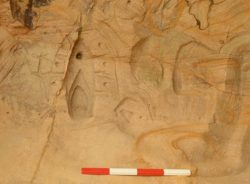 Abraham Lincoln
If given the truth, the people can be depended upon to meet any national crisis...
Abraham Lincoln
If given the truth, the people can be depended upon to meet any national crisis...
 Guildford news...
for Guildford people, brought to you by Guildford reporters - Guildford's own news service
Guildford news...
for Guildford people, brought to you by Guildford reporters - Guildford's own news service
Letter: Hermit’s Cave at St Catherine’s Possible, And Fascinating
Published on: 6 Apr, 2020
Updated on: 6 Apr, 2020
 From: Dr Mary Alexander
From: Dr Mary Alexander
former collections officer at Guildford Museum
In response to – Revealed: Markings Inside the Mystery Medieval Cave Found at St Catherine’s Hill
The astonishing photos of the cave on St Catherine’s Hill show what look very like medieval carvings.
They are slightly similar to the carvings in the chapel of Guildford Castle keep, but the castle carvings are much better done, perhaps because they are in chalk. (They may be the work of 14th-century prisoners.)
Hermits date from the early days of Christianity. John the Baptist was an early example, and hermits were particularly common during the third and fourth centuries in the deserts of the east. They wanted to be alone to worship God. Nowadays, hermits are rare and unusual, but still exist.
In the earlier Middle Ages, hermits often rejected the normal religious life of a monastery to lead a much more austere life of contemplation. They were often priests, and sometimes lived in groups.
Later, hermits were more humble people, often not priests, mostly illiterate and were self-sufficient. They have been divided into six main types depending on where they chose to live. If we have had a hermit at St Catherine’s he would fit into the cave group, or possibly the highway and bridge group.
The hill is on a trackway along the greensand, which crosses the river at the bottom of the hill and continues on west, parallel with the chalk ridge. The natural river course has been moved and embanked to run at the foot of the hill, not along the lowest part of the valley.
This was probably done in Saxon times to provide a head of water for the mill in Guildford. So travellers needed a ferry or a bridge to get over the river. The written evidence of the time is not definite, but there seems to have been a ferry.
It is possible that the hermit ran the ferry, a typical occupation. He would collect alms from passengers for himself and the chapel. It is also possible he was the chaplain, in which case he would have been a priest needing a nearby dwelling and he may have dug out the cave as a retreat.
We don’t know yet if the cave could have been lived in, but it is a sign that there was more happening at St Catherine’s than we ever dreamed of.
Recent Articles
- Surrey Police Crackdown Shows Serious Rise In Drug-Driving
- Letter: Too Many Years Have Been Lost Awaiting This Decision
- Guildford’s First “Living School Gate” Delivers Major Health and Environmental Benefits
- Flashback: Church Says Plans Are Progressing Well In Bid To Sell Off Graveyard
- Letter: Council Should Use Computer Modelling When Deciding Harm of Planning Applications
- Letter: The National Trust Needs to Speed Up
- Highways Bulletin for January 13
- Letter: Anyone Who Thinks Local Government Reorganisation Will Save Money Is Deluded
- Letter: The National Trust Should Be Embarrassed About How Long the Weir Repair Is Taking
- Updated: City’s Match Postponed – Next Home Match February 1


Search in Site
Media Gallery
Dragon Interview: Local Artist Leaves Her Mark At One of England’s Most Historic Buildings
January 21, 2023 / No Comment / Read MoreDragon Interview: Lib Dem Planning Chair: ‘Current Policy Doesn’t Work for Local People’
January 19, 2023 / No Comment / Read MoreA3 Tunnel in Guildford ‘Necessary’ for New Homes, Says Guildford’s MP
January 10, 2023 / No Comment / Read More‘Madness’ for London Road Scheme to Go Ahead Against ‘Huge Opposition’, Says SCC Leader
January 6, 2023 / No Comment / Read MoreCouncillor’s Son Starts Campaign for More Consultation on North Street Plan
December 30, 2022 / No Comment / Read MoreCounty Council Climbs Down Over London Road Works – Further ‘Engagement’ Period Announced
December 14, 2022 / No Comment / Read MoreDragon Interview: GBC Reaction to the Government’s Expected Decision to Relax Housing Targets
December 7, 2022 / No Comment / Read MoreHow Can Our Town Centre Businesses Recover? Watch the Shop Front Debate
May 18, 2020 / No Comment / Read More










Recent Comments